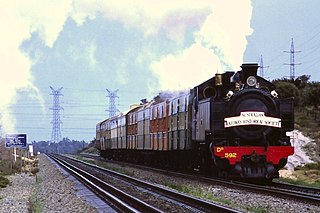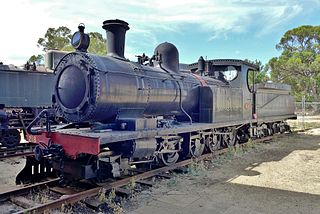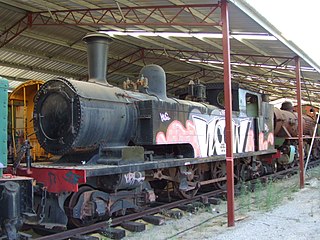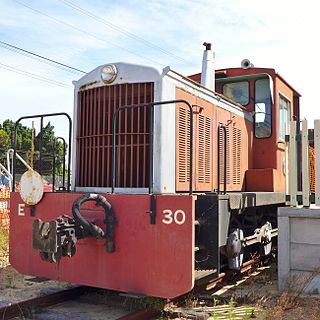The Midland line is a suburban rail service on the Transperth network in Perth, Western Australia. It runs on the Eastern Railway through Perth's eastern suburbs and connects Midland with Perth. Travelling from Midland, the trains terminate at Fremantle on the Fremantle line.
The Fremantle line is a suburban railway and service in Western Australia that connects the central business district (CBD) of Perth with Fremantle.

The Eastern Railway is the main railway route between Fremantle and Northam in Western Australia. It opened in stages between 1881 and 1893. The line continues east to Kalgoorlie as the Eastern Goldfields Railway.

North Fremantle railway station is a railway station on the Transperth network. It is located on the Fremantle line, 16.2 kilometres from Perth, serving the Fremantle suburb of North Fremantle.

The Australind is a currently suspended rural passenger train service in Western Australia operated by Transwa on the South Western Railway between Perth and Bunbury.

Western Australian Government Railways (WAGR) was the state owned operator of railways in the state of Western Australia between October 1890 and June 2003. Owned by the state government, it was renamed a number of times to reflect extra responsibility for tram and ferry operations that it assumed and later relinquished. Westrail was the trading name of the WAGR from September 1975 until December 2000, when the WAGR's freight division and the Westrail brand were privatised. Its freight operations were privatised in December 2000, with all remaining passenger operations transferred to the Public Transport Authority in July 2003.

The Westland was the name given in 1938 to the overnight train operated by the Western Australian Government Railways (WAGR) with sitting and sleeping cars between Perth and Kalgoorlie, where it connected with the Trans-Australian service to Adelaide.

Rail Heritage WA is the local trading name of the Australian Railway Historical Society Inc.

The WAGR X class is a now-withdrawn class of diesel locomotives built by Beyer, Peacock & Company and Metropolitan-Vickers, Bowesfield Works, Stockton-on-Tees for the Western Australian Government Railways (WAGR) between 1954 and 1956. Several members of the class have been preserved.

Railways in Perth, the capital city of Western Australia, have existed since 1881, when the Eastern Railway was opened between Fremantle and Guildford. Today, Perth has seven Transperth suburban rail lines and 79 stations.

The WAGR Dd class was a class of 4-6-4T tank locomotive operated by the Western Australian Government Railways (WAGR) between 1946 and 1972.

The Western Australian Government Railways (WAGR) O Class was a class consisting of fifty-six 2-8-0 steam locomotives which were introduced by the WAGR between 1896 and 1912. Despite them being tender locomotives, they also featured short boiler side tanks for additional water storage. A useful feature for the long distances required by operation on Western Australia's country lines.

The WAGR N class was a class of steam locomotives operated by the Western Australian Government Railways (WAGR) from 1896 until 1960.

The Western Australian Government Railways operated many unique steam, diesel and electric locomotive classes. Often suffering from lack of available funds the WAGR locomotive fleet often consisted of locomotives far older than their expected operational life. Only one electric locomotive was operated by the government during the WAGR years.

The WAGR P and Pr classes were two classes of 4-6-2 steam locomotives designed for express passenger service on the Western Australian Government Railways mainline network. The initial designs were prepared by E.S. Race and together the two classes had a total build number of thirty-five locomotives, the P and Pr classes entering service in 1924 and 1938 respectively. Both classes were used on express passenger services, greatly improving the economy and speed of long-distance passenger travel in Western Australia, the results of which were most visible on the Western Australian stage of the Trans-Australian Railway and Westland Express.

The H class was a class of two steam locomotives operated by the Western Australian Government Railways (WAGR) introduced in 1889.

The MRWA E class was a single member class of diesel-hydraulic shunting (switching) locomotive built by Commonwealth Engineering, Bassendean, Western Australia, for the Midland Railway of Western Australia (MRWA) in 1957. The locomotive was later owned and operated by the MRWA's successor, the Western Australian Government Railways (WAGR).

The WAGR A class was a class of 2-6-0 steam locomotives designed by Beyer, Peacock & Co and operated by the Western Australian Government Railways (WAGR) between 1881 and 1955.

WAGR G class G233 Leschenault Lady is a preserved 2-6-0 steam locomotive, built in 1898 by James Martin & Co of Gawler, South Australia, for the Western Australian Government Railways (WAGR). It is the third oldest Australian-built steam locomotive still in operational order, after Victorian Railways Y class 112 and WAGR A class 15.




















